
Vintage Jockstrap Memorabilia including Advertisements, Packaging, Patent Drawings, etc.
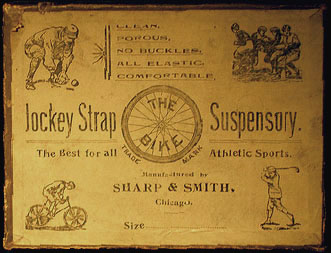 An early example of packaging for the Bike Jockey Strap Suspensory. |
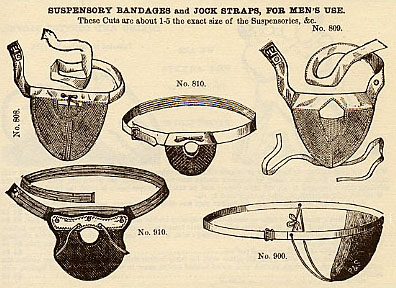 Ad from an 1886 Peck & Snyder sporting goods catalog shows a selection of suspensory bandages and jock straps "for men's use." The description for the jock strap in the lower right reads: "Made of fine cotton band, bag of sateen lined with fine cotton; size of band regulated with buckle, and strings, to tighten the bag, by fastening through eyelet holes. Price, 50 cents." The catalog also featured ads for The New Athlete's Supporter and the "Syracuse" Suspensory Bandage.  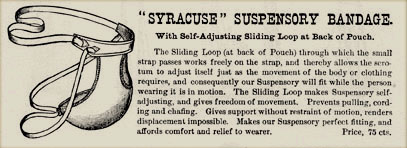 Historical Note One of the earliest references to the use of a suspensory bandage was from a doctor who, writing in 1821, described "a length of cloth in the form of a dhoti, wrapped around the waist and applied tightly between the legs with a hole being cut for the privy member to facilitate urination." |
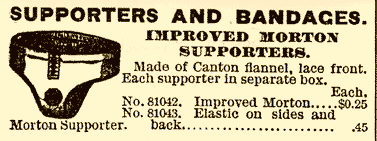 The top song in 1897 was "There'll be a Hot Time in the Old Town Tonight"; William McKinley was President of the United States; the first subway system opened in Boston; and Sears, Roebuck and Company introduced the Improved Morton Supporter to the mail order public. They also listed several Spalding and Old Point suspensories in their catalog. The Morton supporter was made of Canton flannel and had a lace-up front. Historical Note The John B. Flaherty Co. was born in 1898 when John Flaherty began the manufacture of surgical elastic abdominal belts and elastic stockings on hand looms. The factory was a tiny shop, 10 x 20 feet at the rear of his home and his employees included several family members. As the company grew they moved to a larger building and replaced the hand looms with power equipment. It was at this time that his son Charles later took over day-to-day operation of the company. With every passing year more space was required and in 1940 they moved to a block-long, three story plant in the Bronx section of New York. 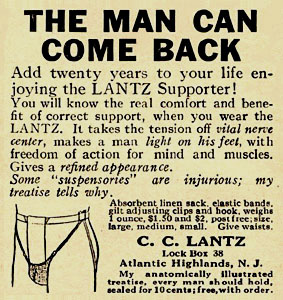 Early advertisement for the Lantz Suspensory Supporter from C. C. Lantz, Atlantic Highlands, NJ. The ad states, "My anatomically illustrated treatise, every man should hold, sealed for 10 cents; free with order." |
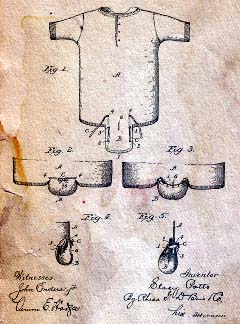 Patent Office drawing from 1900 for the Potts Combination Undershirt/Supporter. A flap located at the front bottom of the shirt was folded under and attached with button snaps to create a "pocket" for holding the testicles. 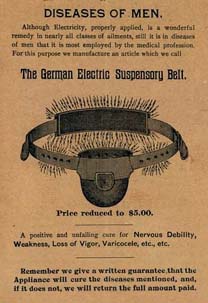 This circa 1901 German Electric Suspensory Belt, advertised as "A positive and unfailing cure for Nervous Disability, Weakness, Loss of Vigor, Varicocele, etc., etc.," applied an electric current to the testicles. It was recommended that the pouch be soaked in salt water before wearing! 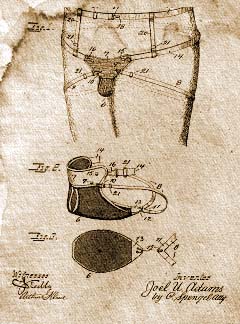 This Patent Office drawing from 1902 is for an Adams Suspensory. |
Three photos circa 1902 show turn-of-the-century men in jock straps. 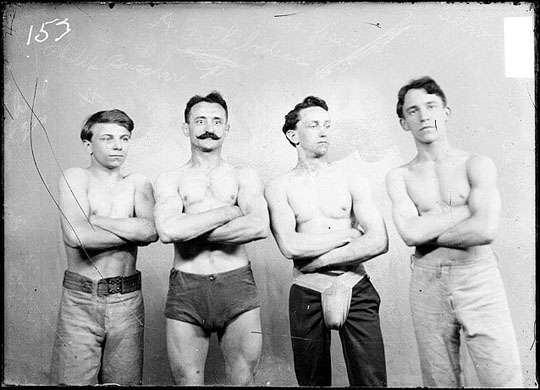 In photo 1, the second man from the right is wearing a V-Front jock over his pants. (Notice that the man to his left appears to be sexually aroused.) 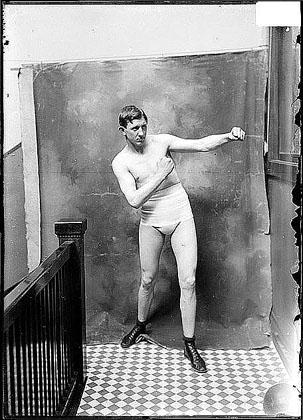 The fighter in photo 2 is wearing an abdominal supporter with a 10" waistband and in photo 3, the second man from the right (kneeling) is wearing a jock strap with extra-wide leg straps. 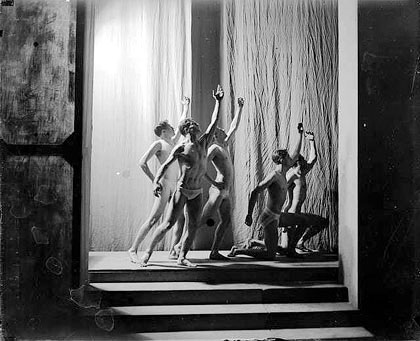 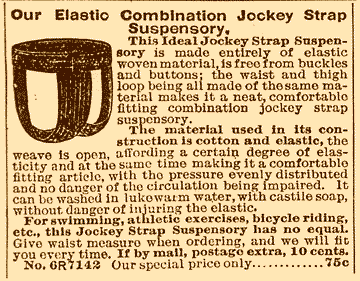 The Ideal Jockey Strap Suspensory was introduced by Sears, Roebuck and Co. in 1902 and sold for 75¢. Historical Note In 1904, Claude "Admiral" Berry, rookie catcher for the Chicago White Sox, became the first major league catcher to wear a protective cup (known at that time as a "safety cup"). Berry later played for the Philadelphia Athletics (1906-07) and the Pittsburgh Rebels (1914-15). |
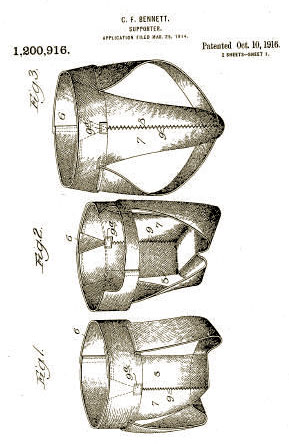 This patent office drawing dated Oct. 10, 1916 shows an improved supporter design by Charles F. Bennett, the undisputed "Father of the Athletic Supporter." |
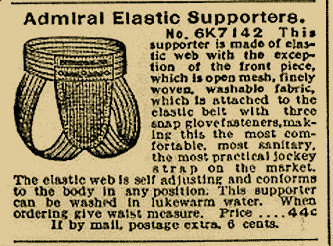 Ad from a 1908 Sears, Roebuck and Co. catalog for the Admiral Elastic Supporter ... "the most comfortable, most sanitary, the most practical jockey strap on the market." The Admiral sold for 44¢ in Sears stores; "If by mail, postage extra, 6 cents." |
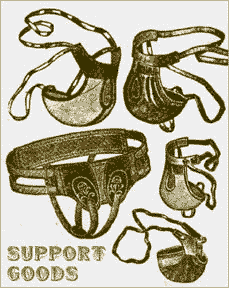 A Acollection of suspensories from a surgical goods catalog (c. 1910). |
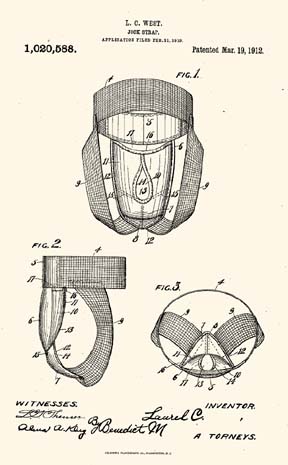 Patent Office drawing for a jock strap design by L. C. West. The patent application was filed February 21, 1910 and the supporter was patented March 19, 1912. |
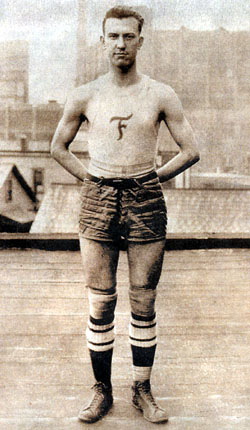 Basketball star Charles "Chuck" Taylor, shown here in a 1921 photo, exhibits a very 21st century attitude toward displaying his jockstrap. Note the waistband of what appears to be a Bike No. 10 supporter protruding above his shorts. Taylor was best known for his association with the Chuck Taylor All-Stars sneaker. |
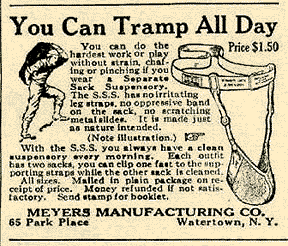 "You Can Tramp All Day" in the Meyers Separate Sack Suspensory from Meyers Manufacturing Co., Watertown, NY. This ad is from a March 1922 magazine. |
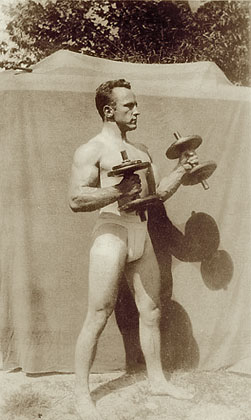 An early 20th century weightlifter proudly displays his muscular body as he poses in a jockstrap. |
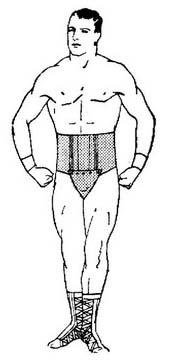 A line drawing from the 1920s shows an athlete in an abdominal supporter with a snap-off pouch. |
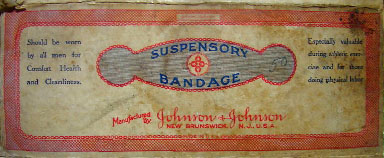 A circa 1922 box for the Johnson & Johnson Suspensory Bandage. "Should be worn by all men for Comfort, Health and Cleanliness." Historical Note The familiar Johnson & Johnson logo was based on the handwriting of James W. Johnson, one of three brothers who founded the company in 1886. James and his brother Edward were the two behind the Johnson & Johnson name. Older brother Robert joined the company several months later after freeing himself from obligations to his previous business, Seabury & Johnson. (It’s a measure of the founders’ foresight that they didn’t change the company name to "Johnson & Johnson & Johnson" when Robert came aboard!) |
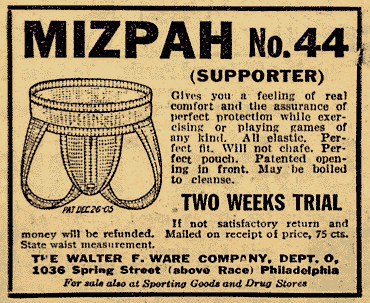 This Mizpah supporter ad, from a 1922 magazine, appeared in the A&E documentary Unmentionables: A Brief History. The Mizpah was sold on a "two weeks trial" and was "mailed on receipt of price, 75 cts." |
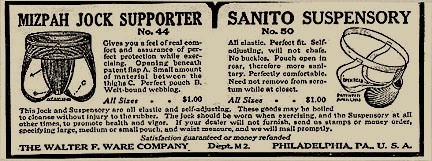 Another Mizpah ad features both the Mizpah No. 44 Jock Supporter and the Sanito No. 50 Suspensory. Wording in the ad states: "The Jock should be worn when exercising, and the Suspensory at all other times, to promote health and vigor." |
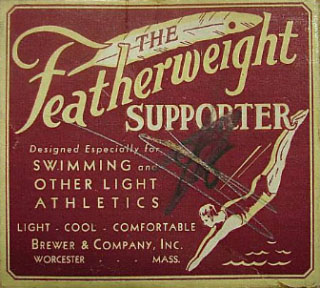 Box for The Featherweight Supporter, "Designed Especially for Swimming and Other Light Athletics." It was manufactured by Brewer & Company, Inc., Worcester, Mass. |
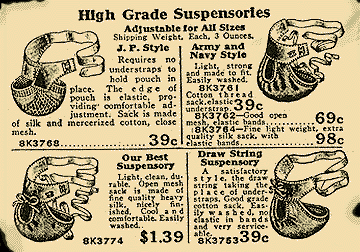 Before jockstraps, men wore the suspensory bandage to prevent their testicles from bouncing against the hard wooden seats of their horse-drawn wagons. This is from the 1927 Sears, Roebuck & Co. catalog. |
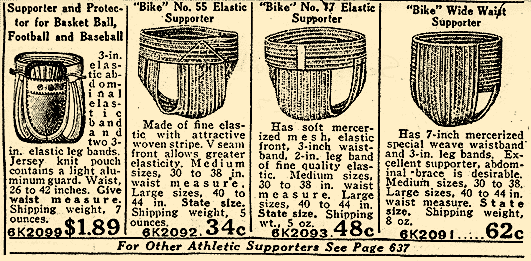 In 1927, men could buy either the Bike No. 55 Elastic Supporter, the Bike No. 17 Elastic Supporter, or the Bike Wide Waist Supporter from the Sears, Roebuck and Co. catalog for as little as 34¢. Notice the "Supporter and Protector for Basket Ball, Football and Baseball" on the left. The "Jersey knit pouch contains a light aluminum guard." |
 Another ad for Athletic Elastic Supporters from the 1927 Sears, Roebuck and Co. catalog included the "Improved Chicago Snap Front" and "The Strap Supporter," both made for Sears by Bike. |
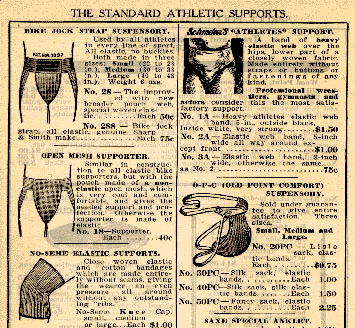 Page from Schmelzer's Sporting Goods catalog shows the Bike No. 28 Jock Strap Suspensory (50¢); the Open Mesh Supporter (40¢); Schmelzer's "Athletes" Support (75¢-$1.50); and the Old Point Comfort Suspensory (75¢-$2.25). Historical Note Charles J. Schmelzer was born in Hartford, CT on July 23, 1856. His parents moved to Leavenworth, KS in 1857 where his father started the pioneer sporting goods house of the West. After going through the public schools, Charles went to work at his father's store and remained connected with the business throughout the rest of his life. The business moved to Kansas City in 1887 where it grew to become the largest sporting goods store of its kind in the world. |
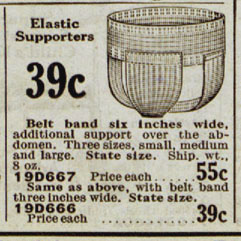 This ad from a 1928 Sears, Roebuck and Co. catalog shows an Elastic Supporter with 3" belt band which sold for 39¢. The 6" belt band model, offering "additional support over the abdomen," was 55¢. |
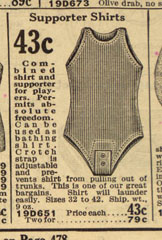 Another interesting jock-related item from the 1928 Sears, Roebuck and Co. catalog is this Supporter Shirt which sold for just 43¢. "Combined shirt and supporter for players. Crotch strap is adjustable and prevents shirt from pulling out of trunks." |
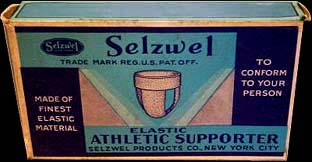 This is the box for a 1920s Selzwell Elastic Athletic Supporter from Selzwel Products Company, New York City. "Made of finest elastic material ... to conform to your person." |
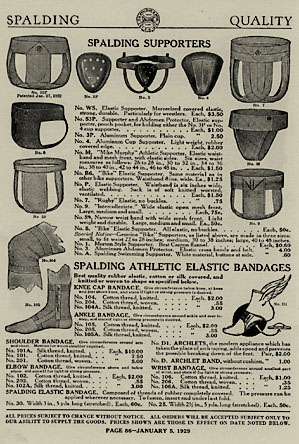 Page from a 1929 Spalding Athletic Goods catalog. Interesting artwork shows a variety of styles including a Spalding Elastic Supporter, Supporter and Abdomen Protector, Aluminum Cup Supporter, Mike Murphy Athletic Supporter, Rugby Elastic and more. |
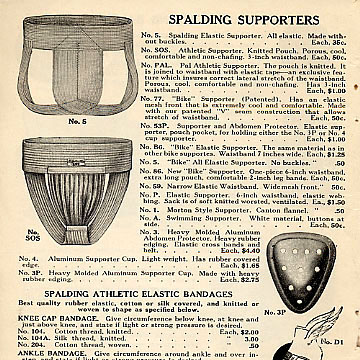 Another page, this one from a 1933 Spalding Athletic Goods catalog, 1933 shows the Spalding Elastic Supporter No. 5 (35¢), the SOS (50¢), as well as two aluminum cups, the No. 4 which is the lightweight model ($1.65) and the No. 3P heavy-duty model ($2.75). Historical Note Having played baseball throughout his youth, Albert G. "Al" Spalding first played competitively with a youth team, the Rockford Pioneers, in 1865 and in 1867 he accepted a $40 per week contract to play for the Chicago Excelsiors. Following the formation of the National Association, baseball's first professional league, he joined the Boston Red Stockings in 1871 and the Chicago White Stockings of the newly formed National League in 1876. Al Spalding retired from baseball in 1878 and opened a sporting goods store in Chicago. He continued adding to his sporting goods empire by purchasing his rivals instead of competing against them. A. G. Spalding Sporting Goods, a household name for 127 years, was acquired by the Russell Corporation in 2003 for $65 million. Annual wholesale revenue for the Spalding brand name in 2002, including licensed products, was over $300 million. |
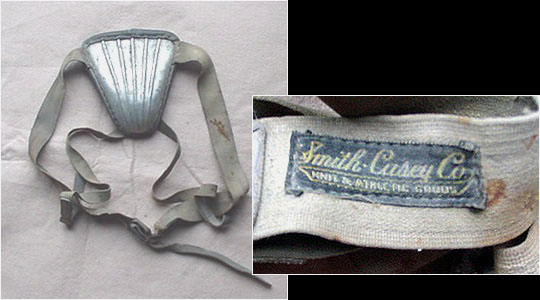 1930s Smith-Casey aluminum cup supporter from the "Smith-Casey Co., Knit & Athletic Goods." The cotton waistband secures in the back with a metal buckle. |
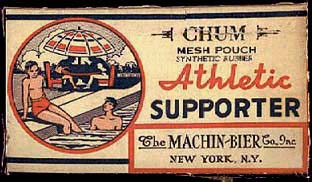 Box for a Chum Mesh Pouch Athletic Supporter from Machin-Bier Company of New York. This supporter was manufactured using synthetic rubber. Machin-Bier was also a supplier of surgical dressings during World War II. |
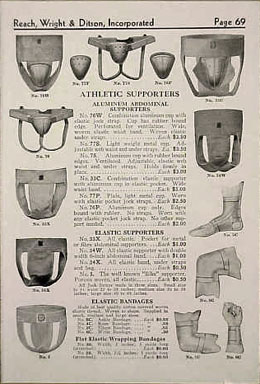 Page 69 from an old Reach, Wright & Ditson catalog shows a selection of abdominal supporters with aluminum cups, elastic supporters and elastic bandages. Historical Note George Wright and Henry A. Ditson each owned sporting goods stores in Boston in the late 1800s. The two stores merged in 1871 to become Wright & Ditson. The company was purchased in 1891 by Al Spalding who retained the Wright & Ditson name. They were joined in the 1930s by Alfred J. Reach, a former Philadelphia Athletics player and owner of Reach Sporting Goods. With the addition of Reach as a partner, the company name was changed to "A. J. Reach, Wright & Ditson, Inc." Alfred Reach, George Wright and Henry Ditson are remembered not only as outstanding athletes, but as key players in the sporting goods and athletic apparel industry in the late 1800s and early 1900s. |
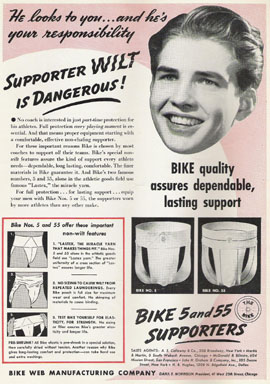 Magazine ad from 1941 shows that the Bike No. 5 and 55 supporters prevent "dangerous supporter wilt." |
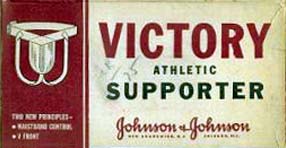 Box from a 1943 Johnson & Johnson Victory athletic supporter. Because rubber was needed for the war effort, this supporter contained no rubber. Waist size was adjusted by way of a metal ring attached to the back of the waistband. |
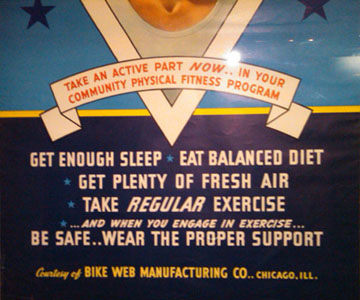 Bottom half of a WWII poster from a Lincoln, NE museum shows the importance of keeping fit for the war effort. Produced by the Bike Web Manufacturing Co., it reminds young men to "Be Safe..Wear the Proper Support." |
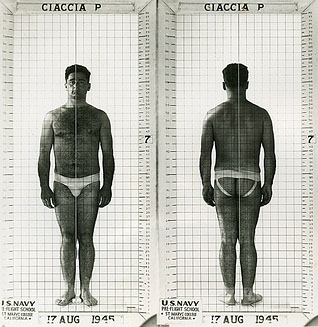 World War II photos of P. Ciaccia, U.S. Navy Pre-Flight School, St. Mary's, California, dated 17 AUG 1945. |
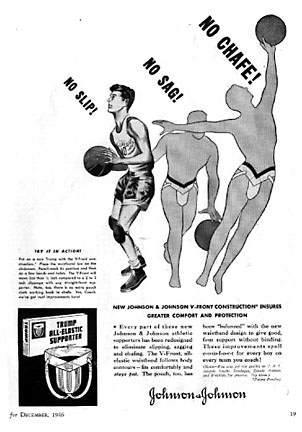 Magazine ad dated December 1946 for the Johnson & Johnson Trump athletic supporter ... "No Slip! No Sag! No Chafe!" |
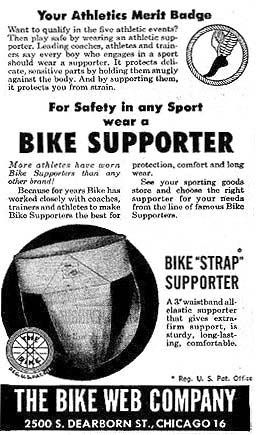
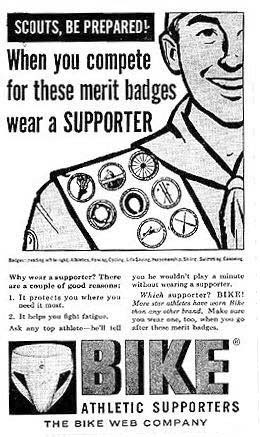 These Bike jock ads appeared in the 1948 and 1955 editions of the Boy Scouts of America Handbook. |
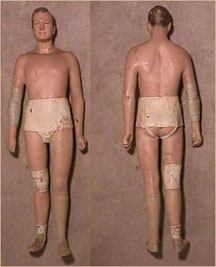 An early drug store display mannequin from the 1940s. He's wearing an elbow brace, wideband supporter, knee brace and ankle brace. |
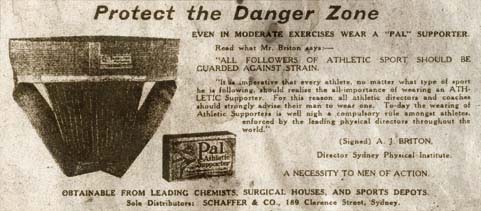 Ad for the Pal Athletic Supporter is from an Australian magazine circa 1940. |
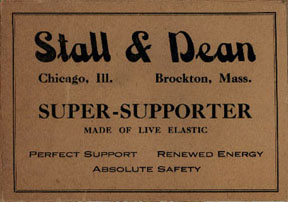 Rare vintage box for the Stall & Dean Super-Supporter ... "Made of Live Elastic." Historical Note The Stall & Dean Manufacturer Co. was founded in 1898 by W. T. Stall of Brockton, MA and C. H. Dean of Chicago, IL. Today the company is located in Carlstadt, NJ and sells athletic T-shirts, jackets, hoodies and caps. 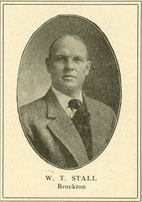
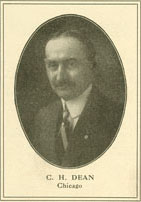 |
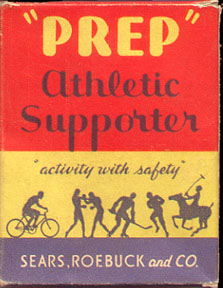 Colorful box for the "PREP" Athletic Supporter promoting "activity with safety." While the "PREP" was sold by Sears, Roebuck and Co., all supporters sold by Sears were manufactured by outside suppliers. |
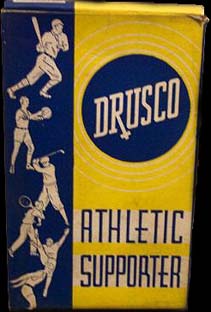 Found in an old store warehouse that closed in the 1950s, this vintage Drusco Athletic Supporter is probably from the same era. The box has period graphics of a baseball player, basketball player, golfer, tennis player, football player and a swimmer. It was manufactured by D.S.A., New York. |
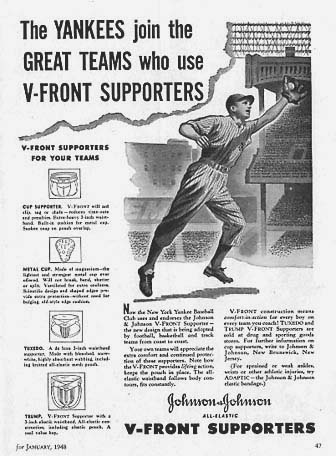 January 1948 magazine ad for Johnson & Johnson V-Front supporters (note the metal cup). "Used and endorsed by The New York Yankee Baseball Club." |
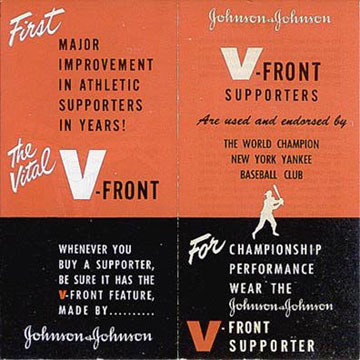 Paper insert from an old Trump jockstrap box shows again that Trump was "used and endorsed by the World Champion New York Yankees Baseball Club." 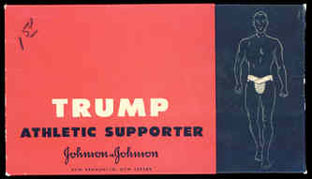 |
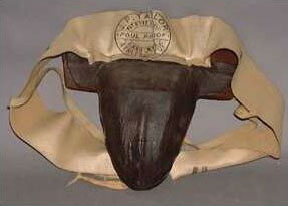 This mid-1900s boxer's cup, the Foul-Proof (appropriately named), was made by the J. P. Taylor Company. |
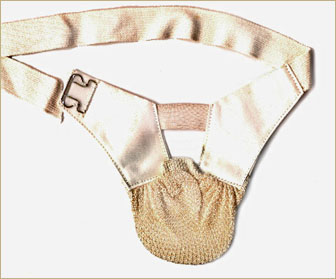 This Extra Quality Suspensory Bandage from 1950s England has a "ball bag" of very silky flesh-colored material. The box indicates "For Surgical & General Purposes." 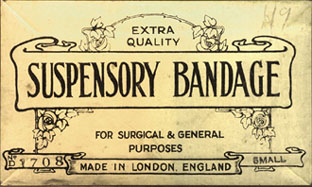 |
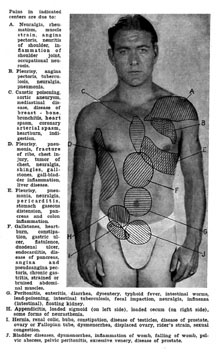 Page from an early 1950s medical book showing a man in a regular band jock strap. Marked areas show pain centers in the upper torso. |
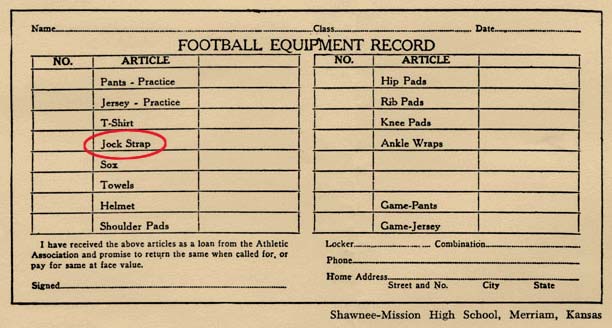 Football Equipment Record from Shawnee-Mission High School, Merriam, KS, lists football equipment the players received "as a loan" at the beginning of the 1951 school year and indicates that the player promises "to return the same when called for, or pay for same at fair value." |
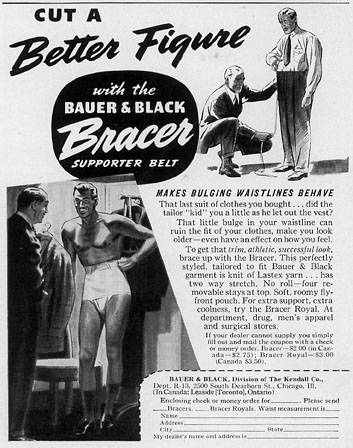 Magazine ad for the Bauer & Black Bracer supporter belt. The price by mail was $2.00 for the Bracer and $3.00 for the Bracer Royal. A later ad shows that the price for the Bracer has increased to $3.50 and the Bracer Royal to $5.00! 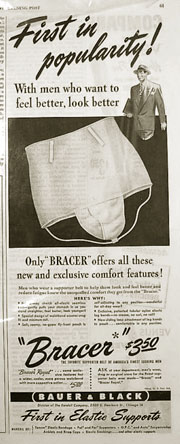 |
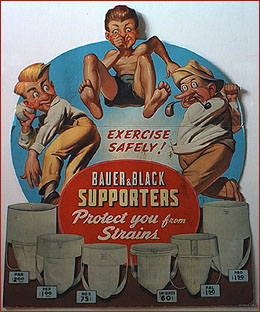 A die-cut cardboard drug store display from the 1950s used colorful cartoon characters to sell Bauer & Black supporters. Historical Note Kendall Mills, Inc. acquired Bauer & Black in 1928 and changed their name to The Kendall Company. Later acquisitions included the Bike Web Manufacturing Company in 1929; another finishing plant at Griswoldville, MA in 1932; and the Burson Knitting Company in 1948. |
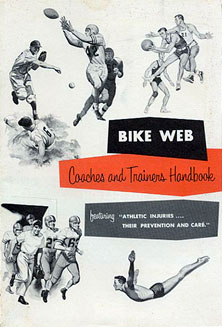 This 1955 "Coaches and Trainers Handbook" from the Bike Web Company provided information on prevention and care of athletic injuries. It featured famous trainers of the day including Bill Dayton, Pinky Newell, Fred Peterson, Henry Schmidt, and Duke Wyre. |
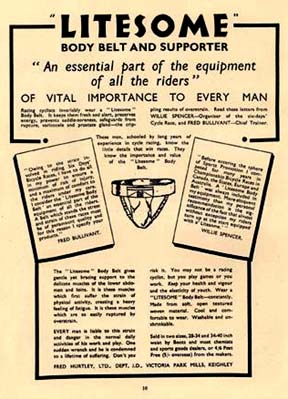 Ad for the Litesome Body Belt and Supporter. "An essential part of the equipment of all the riders ... of vital importance to every man." |
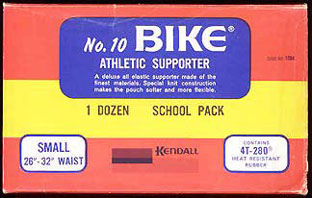 Some manufacturers bulk-pack supporters for school and team sales. This is the Bike No. 10 School Pack. |
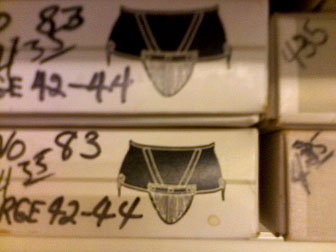 In the mid 1900s, boxes containing suspensories, jockstraps and abdominal supporters were often hidden under counters in small, family-owned drug stores. |
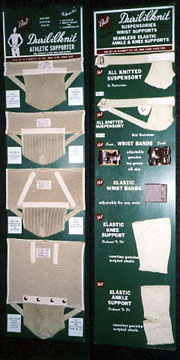 These display panels were rescued from a New York City drug store shortly before it was torn down. They feature full size samples of "Bub" Duribilknit athletic supporters, suspensories and other elastic goods mounted on 1' x 4' screen printed plywood. The panel on the left, a gift from one of my website visitors, was permanently sealed in a museum-quality Plexiglas display case and was given to the Smithsonian Institution's Museum of American History in Washington, D.C. in early October of 2011. The J. B. Flaherty Co. began manufacturing athletic supporters in 1898. |
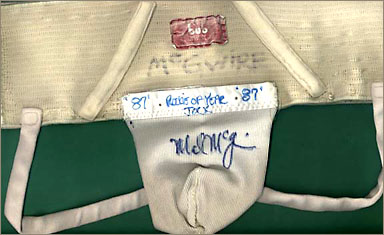 "Bub" cup-style jockstrap worn by Mark McGwire when he was named American League Rookie of the Year in 1987. 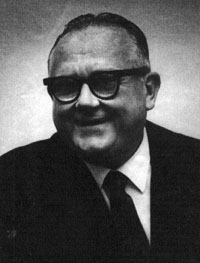 Historical Note Charles J. Flaherty, Sr. and his company, the J. B. Flaherty Co., Inc., were known throughout the industry for athletic supporters and other personal protective products. In the mid 1930s, Mr. Flaherty developed the "Bub" Duribilknit line. Bub supporters were the first to be made with continuous strands of strong surgical elastic; the first to be made by a process that prevented "creeping" of the elastic threads; the first to "custom fit" construction for added protection from strain and more serious injury; and the first to use a patented "flesh elastic" that prevented cutting and chafing. Charles Flaherty is also known as an innovator in the packaging of athletic supporters by openly displaying jockstraps on wire racks instead of hiding them under counters. The lower-priced "Flarico" line, introduced in the 1950s, is a good example. 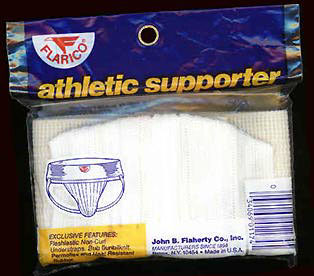 |
 The Danskins dance belt is designed to support the genitals of male ballet dancers. While not "traditional" jockstraps (dance belts have a single strap in the back), they do basically the same thing – offer support where a man needs it most! |
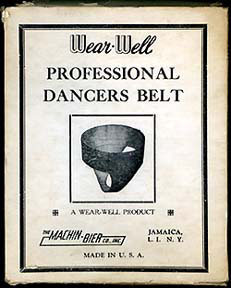 A box from a mid-century Wear-Well Professional Dancers Belt from Machin-Bier Co., Inc., Jamaica, L.I., N.Y. |
| Page from the Apollo 11 Technical Crew Debriefing Manual (PDF file requires Adobe Acrobat Reader) dated July 31, 1969 shows that the first men who walked on the moon wore athletic supporters. |
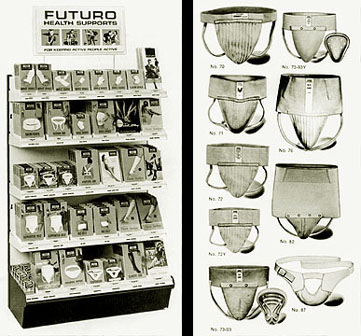 Futuro Health Supports published a retailer's handbook in 1974 with pictures of their complete line of athletic supporters as well as a picture of the display stand furnished to retailers for the various Futuro products. |
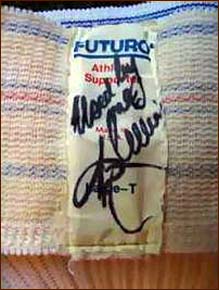 Australian cricket champion Dennis Lillee autographed his Futuro athletic supporter. |
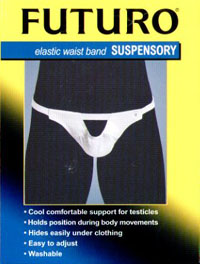 Packaging for the Futuro elastic waist band suspensory ... "Cool comfortable support for testicles." Historical Note The history of Futuro Health Supports began in Cincinnati, OH in 1917 when George "Jack" Jung, Jr. injured his foot and wrapped it with adhesive tape so he could continue playing football. He continued exploring more supportive and comfortable materials and, in the 1930s, branded the company name as "Futuro." Futuro debuted their first in-store supporter display to drug stores in 1955 and today, with production facilities still in Cincinnati, they continue to offer a complete line of support and compression hosiery products to over 40 countries. |
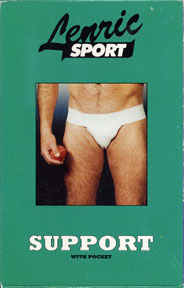 Box for the Lenric Sport Support with Pocket from Lenric International, West Sussex, England. |
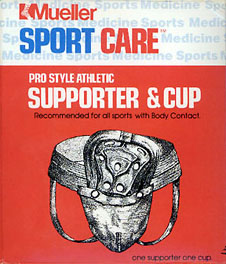 Box for the Mueller Sport Care Pro Style Athletic Supporter & Cup. |
 This Bike jockstrap was worn by Boston Red Sox player Wade Boggs during spring training in Florida. |
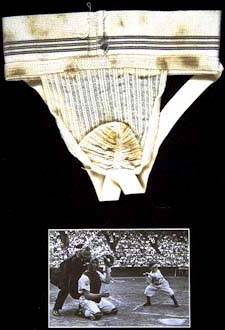 Athletic supporter worn by 3' 7" Eddie Gaedel, pinch-hitter for the St. Louis Browns in 1951. It was retrieved from the locker room floor at Sportsman's Park. |
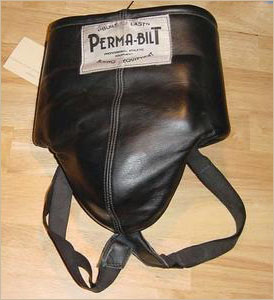 This black leather Perma-Bilt boxer's groin guard was a prop for the hit movie "Rocky" starring Sylvester Stallone. |
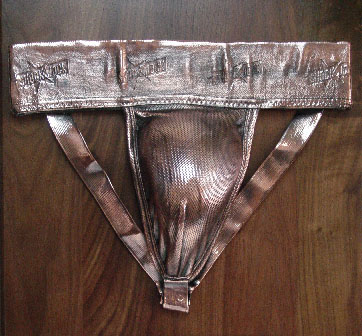 A major sports equipment company used this bronzed and mounted jockstrap as an employee sales award. |
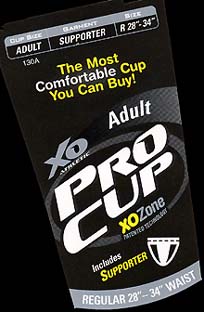 The manufacturer of the XO Athletic Pro Cup advertises it as "The Most Comfortable Jock You Can Buy!" |
Terms of Agreement | Privacy Policy
Contact us: webmaster @ allkink.com